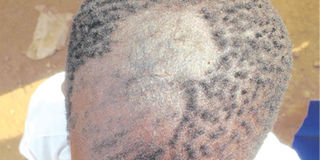The childhood nostalgia of fungal attacks on the head

Parents usually report a long standing history of circular itchy hairless region on the scalp—the top of the head.
PHOTOS | FILE
What you need to know:
- Though head fungal infection is not life threatening, it can turn out to be a childhood nightmare.
Unlike on most other weekends that usually found me at my working place—the hospital, the last Saturday but one, I was at home in Dar es Salaam. As a doctor, weekends can at times turn into working days.
This time around, I took advantage of the festive season and the weekends to visit colleagues and former classmates. It was time to remind ourselves of the good old days in school and in life.
One of the colleagues I visited, exposed me to something that I would love to share with you—it’s a health issue that, as medical doctor, I feel obliged to let you know about it.
How it cropped up
As I conversed with my colleague, we shared the joyful memories of the previous festivals. I told him of our family traditions. In return, he showed me his family pictures, most of which were taken during festive seasons.
“It was the time that our family was reuniting after long while,” he said to me.
Well, I must admit, he comes from a well-off family but what he showed me on that day, attracted a lot of questions and it made us (him and I) end up in mixture of laugher and nostalgia.
Most of the photos featured him next to his parents and the older brother, a family of four.
In almost all of them, they are seen either sitting at their home, around a table or in an expensive hotel. As we cast eyes through them, I started to notice an odd pattern.
Despite the exquisite that the pictures portrayed on my eyes, I noticed two awkward-looking roundish hairless patches on my friend’s head. They were in every picture that was taken during his childhood.
“Is this what I think it is?” I asked him, wondering what his response would be. Then, he answered, “Yes bro.” He did this with a broad smile on his face, perhaps telling me that to him it was a normal thing.
He knows I usually write this column for Your Health, so he told me, as he laughed, “Now I have given you something to write about…”
He went on laughing and then recalled, saying, “Those fungal infections were a nightmare to me during my childhood. They made me have a funny look on my head.”
“Indeed...it was funny,” I told him, jokingly. “I wonder how you would appear like if you still had them up to this age”.
Then, we all laughed in tandem at the very thought of that. It was rather interesting.
But, on a serious note, this was what we refer to, medically as scalp fungal infection or Tinea capitis. It’s a head fungal infection and is one of the commonest complaints of parents and caretakers during childhood.
It’s popular in Kiswahili in Tanzania as “mapunye”. As a general practitioner I do manage as many cases of mapunye as I do for malaria among the clients, who happen to be mainly children.
Parents usually report a long standing history of circular itchy hairless region on the scalp—the top of the head.
There is this common narrative from one of my patients. “My child has been having this fungus on head for months now. We have applied different topical antifungal agents but there is no success.” “They seem to come over and over again.”
The fact that they are not life-threatening explains why most parents would try to manage them at home before they ever seek for medical attention.
Scalp fungal infection, is a common presentation among pre-pubertal children living in overcrowded communities.
Unlike among adults, where they affect immune-compromised individuals, tinea capitis usually affects healthy pre-adolescent children.
How it’s transmitted
The infection can be transmitted through close contact or touching personal items like comb, towels, or bedding. On other hand children can also become infected through contact with infected domestic animals like dog, cat and sometimes cow.
In these children they might have different presentations but commonest features may include patchy hair loss with degree of scaling and reddish-like itching spots.
How is it treated?
Commonly, scalp fungal infections can be cured, if properly managed.
The British Association of Dermatology does recommend antifungal tablets as the standard regimen for the treatment of scalp fungal infection.
Though topical antifungals (tubes) may clear such infection in some people, poor results are always seen in most of the users of these antifungals.
Topical agents and antifungal shampoos, however, are useful in reducing transmission from carriers through reduction of spores of the fungal growth.
“It’s important that your child gets treatment, as severe scalp ringworm could cause a bald patch on his or her scalp” reads an ending note of British Medical Journal’s patient information brochure on scalp fungal infection.
How to prevent it
Children should never share towels, beddings, hats, clothes, combs, or hairbrushes.
Furthermore these should be washed regularly. On other hand if your animal has fungal infection it’s wise to take it to a veterinary expert immediately.
As I envision the image of my friend’s childhood bald head, I wonder who would have wanted to spoil a picture during the past Christmas-New Year festive season due to a treatable scalp infection; definitely not my child.
As we round-off the year and embark on this 2017 today, it is about time we set some keen goals on how to stay healthy both physically and mentally.
I wish all my readers, a prosperous and healthy 2017.
Dr Lopa is Medical Doctor at Rabininsia Memorial Hospital in Dar es Salaam.




